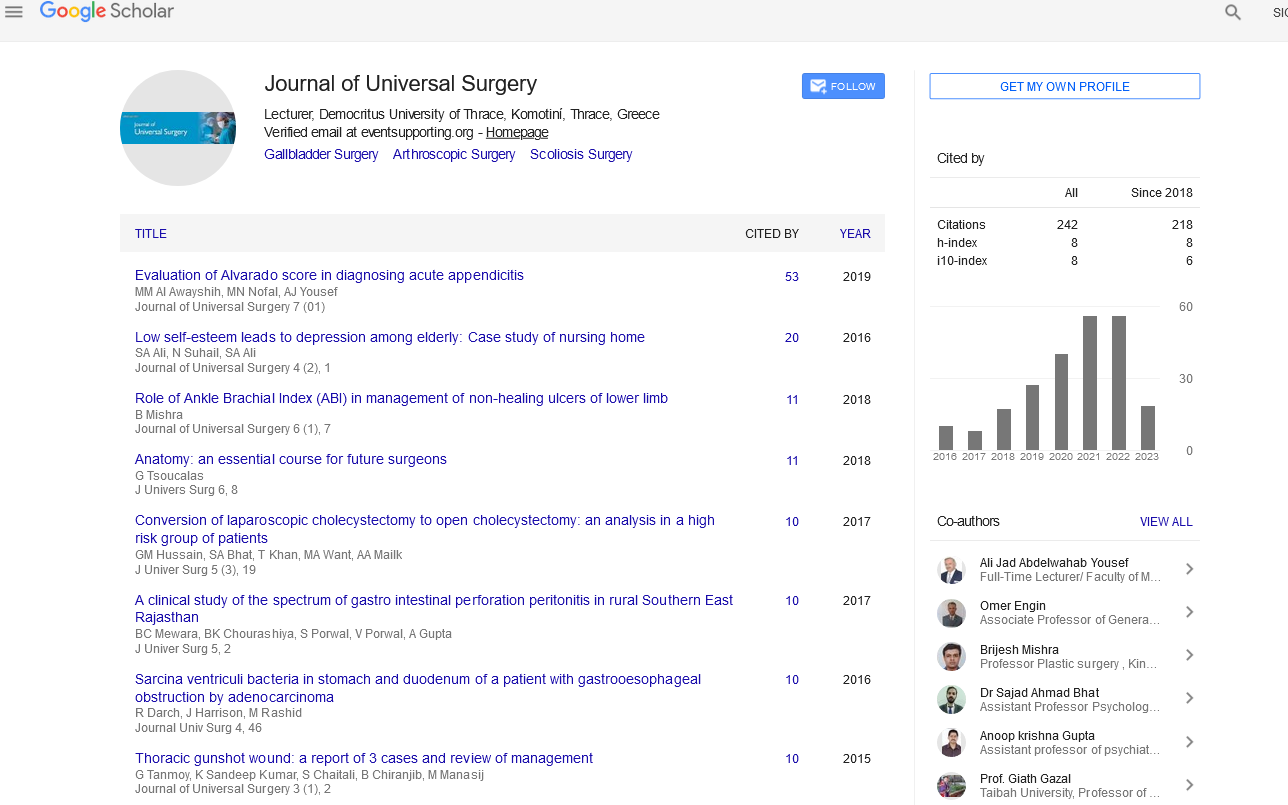Perspective - (2024) Volume 12, Issue 3
Use of Regional Anesthesia in Outpatient Surgery
Adlene Tucker*
Department of General Surgeon, Innsbruck Unversity, Innsbruck, Australia
*Correspondence:
Adlene Tucker, Department of General Surgeon, Innsbruck Unversity, Innsbruck,
Australia,
Email:
Received: 15-May-2024, Manuscript No. IPJUS-24-14860;
Editor assigned: 20-May-2024, Pre QC No. IPJUS-24-14860 (PQ);
Reviewed: 03-Jun-2024, QC No. IPJUS-24-14860;
Revised: 24-Jun-2024, Manuscript No. IPJUS-24-14860 (R);
Published:
27-Jun-2024
Introduction
Regional anesthesia offers advantages for outpatient surgery
due to its proven effectiveness in pain relief and reduction of
complications. This leads to shorter recovery room times and
lower rates of hospital readmission. However, there is a lack of
epidemiological studies that specifically examine the use of
Peripheral Nerve Blocks (PNBs) in this context. Hence, the main
aim of this study was to provide an overview of the overall
utilization of various types of PNBs among all eligible cases in
the outpatient setting in the United States.
Description
More than half of surgical procedures in the United States are
now conducted on an outpatient basis, often in specialized
ambulatory surgery centers that handle a large number of cases.
Regional anesthesia is particularly advantageous in this setting
as it has been shown to improve pain relief and reduce
complications, resulting in shorter recovery room stays and
lower rates of hospital readmission. Unfortunately, there is a
lack of comprehensive epidemiological studies on the overall use
of Peripheral Nerve Blocks (PNBs) in this context. The existing
studies tend to focus on specific surgical procedures or
anatomical locations.
Conversely, nationwide epidemiological data analyzing the
use of regional anesthetics and analgesics across various
anatomic sites and surgical procedures could offer insights into
practice patterns, variances in healthcare delivery, as well as
regional and facility-specific distinctions. Conducting extensive
research is crucial in determining the prevalence of PNBs in
outpatient settings, enabling policymakers, administrators, and
educators to make informed decisions based on valuable data.
NACOR serves as a voluntary submission registry that involves
institutions collaborating to share anesthesia-related data and
outcomes for the purpose of evaluating the quality of care at
both local and national levels. The database is deidentified to
comply with the Health Insurance Portability and Accountability
Act, ensuring the protection of personal information. The
University of California, San Diego institutional review board
exempted the database from the consent requirement. NACOR
receives case-level administrative, clinical, and quality-capture
data from anesthesia practices and healthcare facilities across
the United States on a monthly basis.
Electronic data is collected and mapped to the NACOR schema
using a publicly available data dictionary. Upon arrival, the data
undergo manual and automated reviews to detect missing
elements, mis-coding, and inadvertent corruption. NACOR
contains a wide range of data, including patient demographics,
billing details, procedural information, diagnostic data, and
provider specifics. The study conducted adhered to the relevant
EQUATOR guidelines and involved a retrospective observational
analysis of PNB prevalence in outpatient surgery.
In this retrospective study, we present an analysis of the
utilization rates of different regional anesthesia techniques for
ambulatory surgery based on data from the national database,
NACOR. This study represents the first comprehensive
investigation into the frequency of PNB in the outpatient setting.
The majority of facilities offering these services were community
hospitals and freestanding surgery centers, with university
hospitals representing a smaller proportion. The overall
utilization rates of PNB for cases suitable for this technique were
relatively low, at approximately 3%. Among the various types of
PNB, nerve blocks targeting the brachial plexus, femoral nerve,
and sciatic nerve were the most commonly performed.
Orthopedic procedures accounted for the majority of outpatient
surgeries where PNBs were utilized. Notably, there has been a
significant increase in the frequency of regional anesthesia
procedures from 2010 to 2015. However, while the total number
of continuous PNBs has risen, the proportion of continuous PNBs
compared to single injections has not shown a corresponding
increase. These findings are crucial for understanding practice
trends, patterns, and potential disparities in healthcare delivery.
Regional anesthesia in the outpatient setting has the potential
to greatly enhance perioperative outcomes, providing better
postoperative pain relief, lower risk of complications like nausea
and vomiting, quicker recovery, decreased resource utilization,
and shorter discharge times. Despite these benefits, only 3% of
surgical procedures suitable for regional anesthesia and
analgesia currently utilize peripheral nerve blocks, whether
single-injection or continuous. The reasons behind this low
adoption rate are unclear and warrant further investigation
through detailed analysis.
In spite of the infrequent utilization of PNB in general, there is
a significantly higher prevalence of regional anesthesia use in
certain orthopedic surgeries.
For instance, regional anesthesia was administered in 40% of
shoulder arthroscopies and 32% of anterior cruciate ligament
reconstructions. However, continuous PNB was only used in
approximately 10% of these cases that received a nerve
block. In the future, research and initiatives could concentrate
on identifying the obstacles to enhancing the utilization of
continuous PNBs for specific outpatient orthopedic procedures.
Conclusion
In spite of the infrequent utilization of PNB in general, there is a
significantly higher prevalence of regional anesthesia use in
certain orthopedic surgeries.
For instance, regional anesthesia was administered in 40% of
shoulder arthroscopies and 32% of anterior cruciate ligament
reconstructions. However, continuous PNB was only used in
approximately 10% of these cases that received a nerve
block. In the future, research and initiatives could concentrate
on identifying the obstacles to enhancing the utilization of
continuous PNBs for specific outpatient orthopedic procedures.
Citation: Tucker A (2024) Use of Regional Anesthesia in Outpatient Surgery. J Univ Surg Vol.12 No.3: 023.





